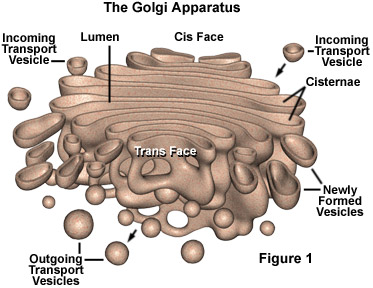The Endomembrane System includes many membranes of eukaryotic cells:
-nuclear envelope
-endoplasmic reticulum
-golgi apparatus
-lysosomes
-vacuoles
-plasma membrane (related)

The membranes may be interrelated directly through physical contact or indirectly through vesicles.
Vesicles are membrane-enclosed sacs that are pinched off pinched off portions of membranes moving from the sight of one membrane to another.
The Endoplasmic Reticulum is an extensive membranous network of tubules and sacs (cisternae) which sequesters its internal lumen (cisternal space) from the cytosol. Two types of ER:
-smooth ER: synthesis of lipids, phospholipids & steroids, carbohydrate metabolism, detoxify drugs & poisons, store calcium for muscle contraction -found in liver
-rough ER: continuous with outer membrane of nuclear envelope, manufactures secretory proteins & membrane
-glycoprotein: protein covalently bonded to carbohydrate
-oligosaccharide: small polymer of sugar units
-transport vesicle: membrane vesicle in transit from one part of the cell to another
Golgi Apparatus are organelles made of stacked, flattened membranous sacs (cisternae), that modify, store, and route products to the ER. Some characteristics include:
-distinct polarity: opposite ends differ in thickness & composition
-cis face receives and trans face pinches off vesicles for transport to other sites

A Lysosome is a membrane-enclosed bag of hydrolytic enzymes that digest all major classes of macromolecules. Some characteristics include: -optimal pH is about 5 -enzymes include lipases, carbohydrates, proteases, & nucleases
-pinch off from trans face of golgi apparatus
1 comment:
The picture of the endomembrane system is great. It shows the vesicle that is pinched off the ER which is in conjunction to the quiz question in class. Good job
Post a Comment